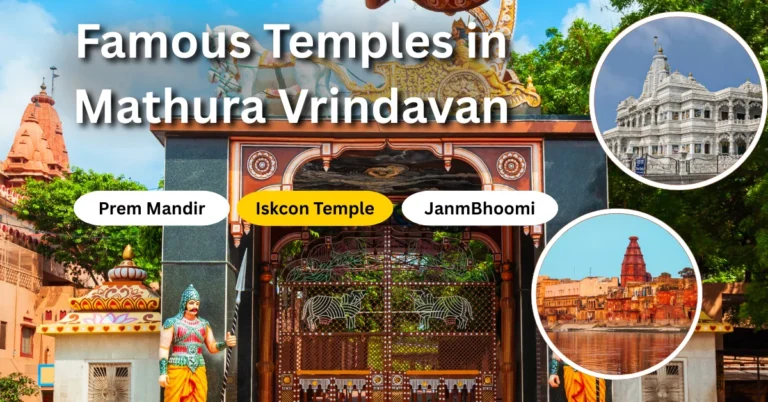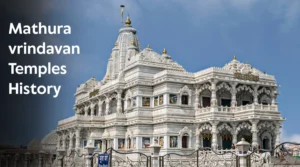How to Experience Mathura and Vrindavan temples Like a Local in the Off-Season isn’t about a checklist; it’s about letting the lanes set your pace—fog-thin mornings, warm lamps at dusk, and an easy hello from the shopkeeper who has already guessed your tea preference. This guide—written in a simple, human voice by mathura vrindavan temples—shows you how to fold yourself into the town’s everyday rhythm without the festival rush.
Table of Contents
ToggleWhy the off-season feels more local
When crowds thin, conversations lengthen. You notice the way a curtain moves between darshans, how aarti-smoke hangs low in winter light, why one courtyard stays quieter than the next. You have time to greet the sevayat, read the day’s board, and choose calm over hurry. That, more than anything, is the difference between visiting and belonging.
Off-season travel tips for Mathura Vrindavan
Use these Off-season travel tips for Mathura Vrindavan to keep your day humane and your heart unhurried:
- Arrive a day early. Sleep well, then meet the town at its gentlest hour—late morning in winter, post-sunset in summer.
- Follow the board, not the blog. Gate notices and a sevayat’s nod beat last month’s internet list.
- Carry warmth and water. Shawl for cold marble, light bottle for long lanes; comfort extends devotion.
- Move between two bells. Reach a few minutes before aarti, linger a few minutes after—silence is part of the darshan.
- Eat like a neighbor. Morning kachori, noon thali, evening milk—small, local, and fresh.
- Pick three shrines a day. Banke Bihari for pulse, Radha Raman for hush, ISKCON for cadence; keep space between visits.
- Talk softly, tip fairly. A small thank-you to the rickshaw-wallah or prasad-seller travels a long way.
Local temple rituals in Mathura and Vrindavan
Understanding Local temple rituals in Mathura and Vrindavan helps you blend in with grace:
- Maṅgalā Aarti (pre-dawn): In winter, aim for the first light after fog; arrive early, wrap warm, and keep phones away.
- Sringar & Bhog: Mid-morning adornment and offering—watch quietly from the side; let the sevā teach you the rhythm.
- Parikrama: Clockwise, unhurried, eyes level; offer way to elders.
- Gau-seva & dān: If you choose to donate, do it discreetly; intention matters more than volume.
- Photography etiquette: Some shrines restrict photos during specific sevas; when in doubt, don’t click—remember, being present is better than proof.
Best time to visit Mathura Vrindavan without crowds
If you want the Best time to visit Mathura Vrindavan without crowds, think in windows rather than months:
- Daily windows: Late morning after fog (winter), early evenings on non-festival weekdays, and the quiet hour after afternoon rest.
- Seasonal windows: Shoulder weeks around big festivals (a few days before/after) often feel kinder; monsoon drizzle brings green lanes and gentler queues.
- Micro-timing: Arrive five minutes before aarti and stay five minutes after; those ten minutes are where the town reveals itself.
Planning with mathura vrindavan temples? Tell us your pace—elders, kids, specific shrines—and we’ll nudge you toward the right hour without rushing your prayer.
A two-day, local-style off-season plan
Day 1 — Listen to the town
- Morning: Walk the market slowly; buy flowers from the same vendor you’ll greet tomorrow.
- Late morning: Radha Raman; stand to the side, watch the sevā unfold.
- Evening: ISKCON kirtan; sit, sing, and step out for a quiet lassi.
Day 2 — Belong a little more
- Morning after fog: Banke Bihari; arrive early, let the brief darshan be enough.
- Noon: Simple thali; rest—off-season is for lingering, not ticking.
- Dusk: Prem Mandir glow or a calm ghat walk; end with warm milk and a short parikrama.
Small courtesies locals notice
- Dress modestly, keep voices low, and stand aside for those in a hurry.
- Ask before offering help; sometimes presence is all that’s needed.
- Leave each space a little cleaner than you found it—devotion has housekeeping.
What this journey gives back
You come looking for a famous moment; you leave remembering small ones: a bench in winter sun, the way incense curled near a carved pillar, the shopkeeper who kept your coin in the same tin as his prayers. That’s the off-season gift.
FAQs of the How to Experience Mathura and Vrindavan temples Like a Local in the Off-Season
1) Is there a single formula for How to Experience Mathura and Vrindavan temples Like a Local in the Off-Season?
Start with patience: fewer temples, longer pauses, and aarti that you meet a few minutes early. Let the day’s board and a sevayat’s guidance lead you.
2) What are the most practical Off-season travel tips for Mathura Vrindavan?
Arrive a day early, dress for the weather, pick three shrines max per day, and follow gate notices over online lists.
3) Which rituals should I know to blend in with Local temple rituals in Mathura and Vrindavan?
Maṅgalā aarti, śṛṅgār, bhog, parikrama, and simple dān—observed quietly, phones tucked away.
4) When is the Best time to visit Mathura Vrindavan without crowds if I’m bringing elders?
Late morning after fog in winter, early evenings on non-festival weekdays year-round; choose temples with clear pathways and seating.
5) Can mathura vrindavan temples plan a gentle, off-season route for families?
Absolutely—we tailor humane sequences, real-time darshan windows, and small food stops so your day feels local, not rushed
Pack your bags, immerse yourself in the divine aura, and let the spiritual energy of Mathura and Vrindavan temples uplift your soul!
Plan Your Spiritual Journey Today
Have questions or need assistance organizing your visit to the sacred temples of Mathura and Vrindavan? We’re here to help you every step of the way.
Email us at info@mathuravrindavantemples.com
Call or WhatsApp us at +91-7819818361
Let the divine journey begin with Mathura Vrindavan Temples .




